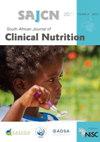南非西开普省和普马兰加省0-5岁儿童的母亲/照顾者对修订后的南非儿童食品膳食指南草案的现场测试概述
IF 0.6
Q4 NUTRITION & DIETETICS
引用次数: 10
摘要
背景:本文概述了一系列研究,旨在评估修订后的南非儿童食品膳食指南草案(SA PFBDG)在0-5岁儿童的母亲/照顾者中的适用性和理解程度。还评估了先前接触具有类似信息的指导方针、障碍和遵循指导方针的促成因素。设计:使用定性方法从38个焦点小组讨论中收集数据(西语=11,南非荷兰语=11,英语=10,西语=6),共有268名参与者。设置:布里德谷街道(伍斯特)、斯特伦博斯市(斯特伦博斯赫、普尼尔和弗兰施霍克)和北大都会(亚特兰蒂斯、威特桑、杜努恩和布隆博格)、西开普省开普敦市以及普马兰加省的埃兰泽尼区(卡博克维尼)。受试者:提供知情同意书的18岁以上的母亲/照顾者。结果:大多数参与者以前接触过与SA PFBDG信息相似的指南。信息来源包括护士、当地诊所、家人、朋友和媒体。遵守准则的可能障碍包括获得资源的物质和财政途径有限;文化/家庭习俗、较差的社会支持和时间限制。过时的信息、误解、不一致的信息和截然不同的信念显而易见。有些信息的词汇没有被很好地理解。关于婴幼儿喂养的教育和指南的视觉描绘可以帮助理解。结论:为了更好地理解修订后的SA PFBDG草案,应考虑一定程度的改写。一旦通过,该指南可用于教育各种利益相关者,包括父母、护理人员、医疗保健提供者和教育工作者,为0-5岁儿童提供正确的营养建议,确保南非幼儿的健康成长和发展。本文章由计算机程序翻译,如有差异,请以英文原文为准。
Overview of field-testing of the revised, draft South African Paediatric Food-Based Dietary Guidelines amongst mothers/caregivers of children aged 0–5 years in the Western Cape and Mpumalanga, South Africa
Background: This paper provides an overview of a series of studies undertaken to assess the appropriateness and understanding of the revised, draft South African Paediatric Food-Based Dietary Guidelines (SA-PFBDGs) amongst mothers/caregivers of children aged 0–5 years. Previous exposure to guidelines with similar messages, barriers and enablers to following the guidelines were also assessed. Design: Qualitative methods were used to collect data from 38 focus-group discussions (isiXhosa = 11, Afrikaans = 11, English = 10 and siSwati = 6) resulting in 268 participants. Setting: Breede Valley sub-district (Worcester), Stellenbosch Municipality (Stellenbosch, Pniel and Franschhoek) and Northern Metropole (Atlantis, Witsand, Du Noon and Blouberg), City of Cape Town, Western Cape province, as well as Ehlanzeni District (Kabokweni) in Mpumalanga province. Subjects: Mothers/caregivers older than 18 years who provided informed consent to participate. Results: The majority of participants had previous exposure to guidelines with similar messages to the SA-PFBDGs. Information sources included nurses, local clinics, family, friends and media. Possible barriers to following the guidelines included limited physical and financial access to resources; cultural/family practices, poor social support and time constraints. Outdated information, misconceptions, inconsistent messages and contrasting beliefs were evident. The vocabulary of some messages was not well understood. Education on infant and young child feeding and visual portrayal of the guidelines could aid understanding. Conclusion: A degree of rewording should be considered for improved understanding of the revised, draft SA-PFBDGs. Once adopted, the guidelines can be used to educate various stakeholders, including parents, caregivers, healthcare providers and educators, on the correct nutritional advice for children aged 0–5 years ensuring the healthy growth and development of young children in South Africa.
求助全文
通过发布文献求助,成功后即可免费获取论文全文。
去求助
来源期刊

South African Journal of Clinical Nutrition
NUTRITION & DIETETICS-
CiteScore
2.50
自引率
9.10%
发文量
21
期刊介绍:
1.The Journal accepts articles from all basic and applied areas of dietetics and human nutrition, including clinical nutrition, community nutrition, food science, food policy, food service management, nutrition policy and public health nutrition. 2.The Journal has a broad interpretation of the field of nutrition and recognizes that there are many factors that determine nutritional status and that need to be the subject of scientific investigation and reported in the Journal. 3.The Journal seeks to serve a broad readership and to provide information that will be useful to the scientific community, the academic community, government and non-government stakeholders in the nutrition field, policy makers and industry.
 求助内容:
求助内容: 应助结果提醒方式:
应助结果提醒方式:


